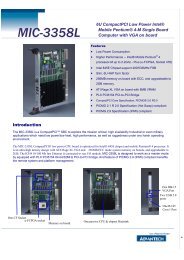industrial wireless book special edition - Networking ...
industrial wireless book special edition - Networking ...
industrial wireless book special edition - Networking ...
You also want an ePaper? Increase the reach of your titles
YUMPU automatically turns print PDFs into web optimized ePapers that Google loves.
Industrial Wireless<br />
New routing improves <strong>wireless</strong><br />
mesh network performance<br />
The main goal of a <strong>wireless</strong> sensor network is to enable reception of data from the sensor field without the<br />
need for physical connection or access. But there should also exist a data path which can run in the opposite<br />
direction: most serious applications also demand control over the networked sensors – true SCADA – which<br />
requires the use of bi-directional networks. Most <strong>wireless</strong> mesh implementations use process-intensive<br />
algorithms to create a self-forming, self-healing single path through the network. Diversity Path Mesh offers<br />
an attractive alternative by routing everything everywhere. Marius Gafen describes a new mesh paradigm<br />
46<br />
THE MAJOR APPLICATION driver for most<br />
<strong>wireless</strong> mesh systems presently relates to<br />
smart electrical metering. These <strong>wireless</strong><br />
networks can be used to build Advanced<br />
Metering Infrastructure (AMI) to continuously<br />
monitor power consumption, control the functionality<br />
of the meters, as well as limit the<br />
end-user consumption or report about<br />
tampering with the metres. They are expected<br />
to handle all these functions in something<br />
close to real time. Such capabilities enable<br />
electric utilities to reduce operational expenses,<br />
implement flexible management systems based<br />
on real time energy consumption, increase the<br />
system’s reliability and ultimately help to<br />
reduce both cost and energy usage.<br />
Flexible mesh topology has shown itself to<br />
offer the best choice for a large range of <strong>wireless</strong><br />
sensor network applications; more often than<br />
not it proves to be the only feasible topology<br />
for modern projects. Critical factors influencing<br />
performance of a <strong>wireless</strong> mesh network vary<br />
from application to application and usually<br />
require most of the following capabilities:<br />
● Range and coverage. These are probably the<br />
most obvious requirements for a <strong>wireless</strong><br />
network, starting from the node-to-node range<br />
at a given transmission power vs antenna gain<br />
vs data rate compromise. Range is affected by<br />
the quality of the physical layer and the<br />
efficiency with which the data propagates<br />
through the network. In mesh topology, the<br />
technology also necessitates subtler and often<br />
more important range-related detail such as<br />
the influence of multipath conditions and<br />
changes, or the way in which the requirements<br />
are affected when the nodes operate in mesh<br />
topology rather than just between two separate<br />
nodes. Coverage requirements are closely<br />
related to range and mainly involve the elimination<br />
of dead spots in the network. The<br />
extent of the coverage area relates to multiples<br />
of the basic node-to-node range.<br />
● Robustness to network changes and RF interference.<br />
Some changes can be internal and<br />
direct such as adding, removing or moving<br />
nodes. Other propagation path factors may<br />
derive from incidental events such as the<br />
addition (or removal) of walls or buildings or,<br />
more trivially, the replacement of a wooden<br />
door in the RF path with a metallic one. Such<br />
influences lead to subtle, but important issues<br />
concerning how the network reacts to changes.<br />
For example, could the network go down as a<br />
result of these events and, if so, for how long?<br />
● Scalability. This means the ability to form<br />
network cells comprising just a few nodes, to<br />
cells with thousands or even tens of thousands<br />
of nodes. While it seems unlikely that <strong>industrial</strong><br />
applications would require such scaling, the<br />
ability to increase the size of an existing<br />
network by orders of magnitude is a definite<br />
requirement in the Utility world. Spatial scalability<br />
is another aspect of the problem. If<br />
network cells which measure a few metres can<br />
be expanded in physical size to kilometres<br />
without recourse to other technologies such<br />
as cellular GSM, this can be a most desirable<br />
property. The number of hops involved in the<br />
geographical deployment of the nodes is a<br />
related concern.<br />
● Power consumption. For many if not most<br />
applications, the longest period of time that a<br />
node can operate from a battery power source<br />
becomes a vital factor, as is the ability to mix<br />
between nodes with various power supply types<br />
and capacity.<br />
● Ease of integration. The way in which a<br />
particular type of network physical layer can<br />
connect up to and coexist with other network<br />
types is an absolutely critical factor. For<br />
example, in some organisations a need to train<br />
the deployment staff in <strong>special</strong>ist network<br />
installation may preclude a move to <strong>wireless</strong>;<br />
in others, the network management resources<br />
may reduce or even annul the operational cost<br />
benefits of the network. Networks that enable<br />
an immediate move from wire to <strong>wireless</strong><br />
without need for new management software or<br />
thorough modifications constitute a powerful<br />
PHOTO: EDF ENERGY<br />
<strong>industrial</strong> ethernet <strong>book</strong><br />
force for network integration, for example, just<br />
by cutting the existing RS485 or Modbus wires<br />
and inserting the <strong>wireless</strong> network nodes.<br />
Despite the fact that mesh topology often<br />
represents the best option for numerous applications,<br />
the vast majority of existing <strong>wireless</strong><br />
network types can be configured to all the<br />
relevant installation topologies, thus<br />
addressing their lowest common denominator.<br />
Does this present a paragon of flexibility or<br />
pointless complexity? We think that such a<br />
strategy can be justified only if the application<br />
requires several topologies to be applied<br />
concomitantly, or at least in the same project.<br />
However, when it is clear that the only possible<br />
<strong>wireless</strong> application topology is mesh, it makes<br />
sense to use a technology targeted specifically<br />
towards mesh topology.<br />
Diversity Path Mesh<br />
This technology is designed to maximise the<br />
most important performance factors of <strong>wireless</strong><br />
mesh networks against their trade-off characteristics<br />
while operating in the crowded ISM<br />
frequency bands. Diversity Path Mesh is a multihop,<br />
bidirectional communication technology,<br />
developed for <strong>wireless</strong> sensor networks using<br />
mesh topology and operating in the unlicensed<br />
frequency bands.<br />
The basic technique behind DPM is the use of<br />
synchronised flooding, where a node transmits<br />
the very same message to all the nodes in the<br />
network cell. The theoretical concept of flooding<br />
in networks as an alternative to routing is well<br />
known. In a flooding-based network, the<br />
message data is sent to all the network<br />
neighbours, thus eliminating the need to route<br />
messages, and enabling the network to use<br />
multiple propagation paths (actually all the<br />
available propagation paths). Such networks<br />
benefit from space diversity, improving overall<br />
network robustness tremendously.<br />
Routing calculation is a most demanding<br />
network management task, and its elimination<br />
by use of message flooding greatly reduces the<br />
demand for processing resources in the node<br />
in terms of CPU power and memory. It also<br />
decreases the amount of data carried in the<br />
network since messages contain only payload<br />
data; there is no overhead in the carriage of<br />
sponsored by Advantech

















